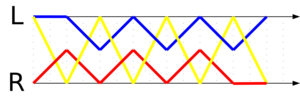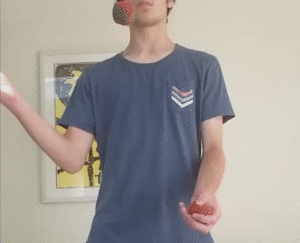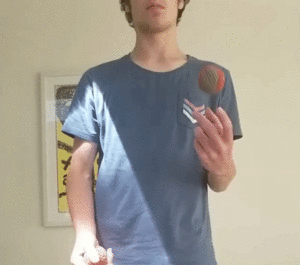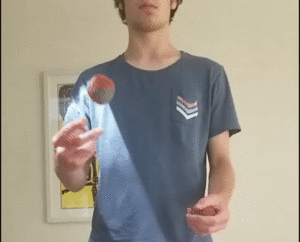Box (juggling) facts for kids
 |
|
| Minimum prop #: 3 | |
| Difficulty: 6/10 (note: difficulty ratings are arbitrary and subject to change) | |
| Siteswap: (4,2x)(2x,4) | |
| Shannon: 12 | |
| Period: 4 | |
| Parity: odd | |
| Notes: asymmetrical, synchronous |
In toss juggling, the box is a cool juggling pattern that uses 3 objects. Most jugglers use balls or bean bags for this trick. Imagine two balls going straight up and down in each hand. The third ball is thrown sideways between your hands, crossing over. This creates a "box" shape with the balls in the air. The special code for this pattern is called a siteswap, and for the box, it's (4,2x)(2x,4).
The box pattern is a bit like a synchronous shower (which is a type of fountain pattern). The difference is that the direction of the throws changes each time. There's also something called the half-box. It's similar but not quite in sync, and its siteswap is 441. People have called the 441 pattern "the simplest non-obvious siteswap" and "a very popular and pretty pattern." Another pattern called the seesaw (siteswap: 612) is also sometimes known as the box. It looks a bit like the 441 pattern but without certain throws.
Different Ways to Throw the Middle Ball
The horizontal throw that crosses between your hands in the box pattern is called the "vamp." In a regular box pattern, this vamp ball goes underneath the other two balls that are moving up and down. But there are a few cool ways to change how you throw this vamp ball!
| Title | What it is | See it in action |
|---|---|---|
| The Shuffle | In a shuffle throw, the vamp ball starts high up and outside the path of one of the side balls. You throw it diagonally downwards, and it's caught below the other side ball. So, it begins with the vamp ball high in the corner and ends in a normal box position. | |
| The Reverse Shuffle | The reverse shuffle is like playing the shuffle throw backward! The ball starts low, just like in a normal box. But you throw it diagonally upwards, and it's caught high up, above the opposite side ball. This means the vamp ball ends up high in the corner of the pattern. | |
| The Inverted Vamp | The inverted vamp goes above both of the side balls, moving between the upper corners of the pattern. This is one of the trickiest vamp types. You need to move the vamp ball very fast, and the side balls can't go too high, so the vamp can fly over them. |
Variations
Inverse Box
In the inverse box, the siteswap (the juggling code) stays the same. Two balls still go in straight lines, but the ball thrown from your right hand goes up and down on your left side, and vice versa. This makes your hands move very quickly! After your right hand throws a ball up on the left side, both hands need to rush to the right so your left hand can throw the next ball on the right side.
Outside Box
The outside box is similar to the original box pattern. The main difference is that the fast horizontal (2x) ball is thrown outside the path of the vertical ball that's coming down. It's also caught outside the next vertical ball you're about to throw. To make this trick look really good, try to throw the 2x ball as straight up and down as possible. If it arcs too much, it loses its cool visual effect.
Luke's Shuffle
Luke's shuffle is another cool variation of the box. In this pattern, the throws that are usually horizontal are thrown diagonally downwards instead. The siteswap stays the same. This trick involves carrying the ball up and over the rising vertical throw. Then, you throw the ball from above that vertical throw, diagonally downwards to your other hand. This downward throw is often called a "shuffle," which gives the trick its name. Luke Jugglestruck (whose real name is Luke Gravett) invented this trick in 1991. He showed it to Charlie Dancey, who then included it in his juggling book.
- The Box from Juggling with Balls.







